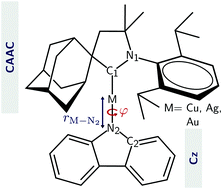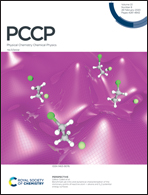Competition between the heavy atom effect and vibronic coupling in donor–bridge–acceptor organometallics†
Abstract
The excited state properties and intersystem crossing dynamics of a series of donor–bridge–acceptor carbene metal-amides based upon the coinage metals Cu, Ag, Au, are investigated using quantum dynamics simulations and supported by photophysical characterisation. The simulated intersystem rates are consistent with experimental observations making it possible to provide a detailed interpretation of the excited state dynamics which ultimately control their functional properties. It is demonstrated that for all complexes there is a competition between the direct intersystem crossing occurring between the 1CT and 3CT states and indirect pathways which couple to an intermediate locally excited ππ* triplet state (3LE) on either the donor or acceptor ligands. The energy of the 3LE states decreases as the size of the metal decreases meaning that the indirect pathway plays an increasingly important role for the lighter metals. Importantly whenever the direct pathway is efficient, the presence of indirect pathways is detrimental to the overall rate of ISC as they provide a slower alternative pathway. Our results provide a detailed insight into the mechanism of intersystem crossing in these complexes and will greatly facilitate the design of new higher performing molecules.



 Please wait while we load your content...
Please wait while we load your content...